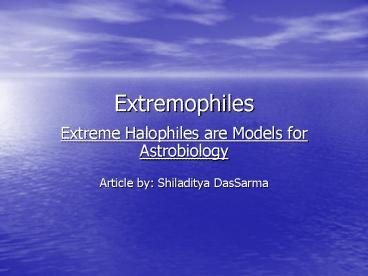Extremophiles - PowerPoint PPT Presentation
1 / 15
Title: Extremophiles
1
Extremophiles
- Extreme Halophiles are Models for Astrobiology
- Article by Shiladitya DasSarma
2
Introduction
- This article specifically focuses on halophiles,
and how they are candidates to be able to survive
on other planets, like mars for instance. - Life on earth needs water but halophiles are one
of the few that can withstand high concentrations
of salts, which results from the evaporation of
water.
3
Halophiles
- Live in high saline environments.
- They can control the amount of salt inside by
osmotic pressure and chemical substances. - They are found in brine salt, or any other areas
with high salt concentrations.
4
Mars
- Mars has polar ice caps at both south and north
poles - There is also evidence of erosion, large floods
and river systems which would suggest that water
was once present . - Mars has an atmosphere that contains nitrogen,
carbon dioxide, argon, and oxygen.
5
Research
- The Great Salt Lake and the Dead Sea are the best
environments to study halophiles and how they can
survive in these salty environments. - Regions of Antarctica, which have permanently
cold high salt concentration, can have
halophiles. - Environments that have high saline are also found
in the earths subsurface, in deep-sea basins.
6
Methods
- Genome sequencing can offer detailed information
on varies halophiles, Proteomes can also offer
detailed information. - The Halobacterium species is a very good
halophile to study and is useful for post-genomic
studies, because it can respond to a series of
different tests. - Testing the growth rate of different organisms in
different concentrations of NaCl can also be
useful for knowing the tolerance level of an
organism.
7
Results and Discussion
- This graph shows the growth rate of an
organism versus NaCl concentration.
8
(No Transcript)
9
Acidic Proteomes
- Figure A shows the protein acidity among
halophiles and other nonhalophiles. - Halophiles have low isoelectric points or (pI).
10
Surface Charges
- Proteins from halophiles typically display high
negative surface charges. - This is because the acidic proteins dissolve
readily in an environment with high salinity and
reduced water.
11
DNA Microarray
- This figure shows gene expression changes in
Halobacterium sp. NRC-1 under aerobic versus
anaerobic growth.
12
DNA Microarray
- In this figure it shows gene expressions for
dmsR versus ?dmsR strains.
13
Photosynthetic membrane
- This graph shows the absorption versus wavelength
of chlorophyll-based photosynthetic membrane and
retinal-based purple membrane.
14
Conclusion
- Since Halophiles are tolerate to so many forms of
environmental stress they are excellent
candidates for the term exophiles. - The European Space Agency has already launched
one halophile in space.
15
Resources
- http//www.nineplanets.org/mars.html
- http//library.thinkquest.org/CR0212089/halo.htm
- Microbe Magazine/Volume 1, Number 3, 2006,
Shiladitya DasSarma. - http//en.wikipedia.org/wiki/DNA_microarray
- http//en.wikipedia.org/wiki/Proteome































